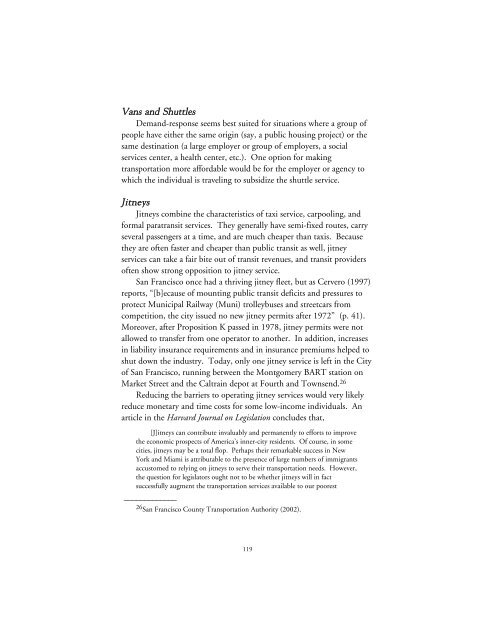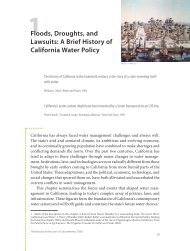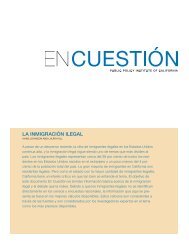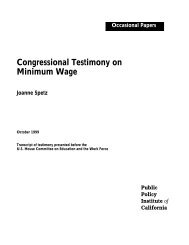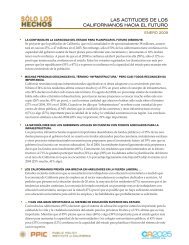Transportation Spending by Low-Income California Households ...
Transportation Spending by Low-Income California Households ...
Transportation Spending by Low-Income California Households ...
You also want an ePaper? Increase the reach of your titles
YUMPU automatically turns print PDFs into web optimized ePapers that Google loves.
Vans and Shuttles<br />
Demand-response seems best suited for situations where a group of<br />
people have either the same origin (say, a public housing project) or the<br />
same destination (a large employer or group of employers, a social<br />
services center, a health center, etc.). One option for making<br />
transportation more affordable would be for the employer or agency to<br />
which the individual is traveling to subsidize the shuttle service.<br />
Jitneys<br />
Jitneys combine the characteristics of taxi service, carpooling, and<br />
formal paratransit services. They generally have semi-fixed routes, carry<br />
several passengers at a time, and are much cheaper than taxis. Because<br />
they are often faster and cheaper than public transit as well, jitney<br />
services can take a fair bite out of transit revenues, and transit providers<br />
often show strong opposition to jitney service.<br />
San Francisco once had a thriving jitney fleet, but as Cervero (1997)<br />
reports, “[b]ecause of mounting public transit deficits and pressures to<br />
protect Municipal Railway (Muni) trolleybuses and streetcars from<br />
competition, the city issued no new jitney permits after 1972” (p. 41).<br />
Moreover, after Proposition K passed in 1978, jitney permits were not<br />
allowed to transfer from one operator to another. In addition, increases<br />
in liability insurance requirements and in insurance premiums helped to<br />
shut down the industry. Today, only one jitney service is left in the City<br />
of San Francisco, running between the Montgomery BART station on<br />
Market Street and the Caltrain depot at Fourth and Townsend. 26<br />
Reducing the barriers to operating jitney services would very likely<br />
reduce monetary and time costs for some low-income individuals. An<br />
article in the Harvard Journal on Legislation concludes that,<br />
[J]itneys can contribute invaluably and permanently to efforts to improve<br />
the economic prospects of America’s inner-city residents. Of course, in some<br />
cities, jitneys may be a total flop. Perhaps their remarkable success in New<br />
York and Miami is attributable to the presence of large numbers of immigrants<br />
accustomed to relying on jitneys to serve their transportation needs. However,<br />
the question for legislators ought not to be whether jitneys will in fact<br />
successfully augment the transportation services available to our poorest<br />
_____________<br />
26 San Francisco County <strong>Transportation</strong> Authority (2002).<br />
119


